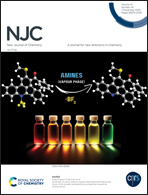A thermo-regulated highly regioselective mono and dihalogenations of phenols and anilines in water employing new Lewis base adducts (LBAs) [DBUBr]+Br− and [DBUI]+I− as green reagents: a simple approach†
Abstract
Herein, an operationally simple temperature-dependant regioselective halogenation of phenols and anilines in water using readily accessible and highly stable Lewis base adducts (LBAs) is reported. These newly discovered LBAs [DBUBr]+Br− and [DBUI]+I− are compatible with a wide range of substrates for regioselective brominations and iodinations with excellent yields (up to 95%), and the products were directly isolated just by filtration and characterized without column chromatographic purification. The organobase DBU was recovered and reused for making corresponding LBAs without a substantial loss of activity. Further halogenations are chemoselective and nucleoselective and proceeded with a very good E-factor. Complimentary regioselectivity (ortho over para) of both aniline and phenol for monohalogenation is a unique feature of the methodology.
![Graphical abstract: A thermo-regulated highly regioselective mono and dihalogenations of phenols and anilines in water employing new Lewis base adducts (LBAs) [DBUBr]+Br− and [DBUI]+I− as green reagents: a simple approach](/en/Image/Get?imageInfo.ImageType=GA&imageInfo.ImageIdentifier.ManuscriptID=D3NJ03370H&imageInfo.ImageIdentifier.Year=2023)


 Please wait while we load your content...
Please wait while we load your content...